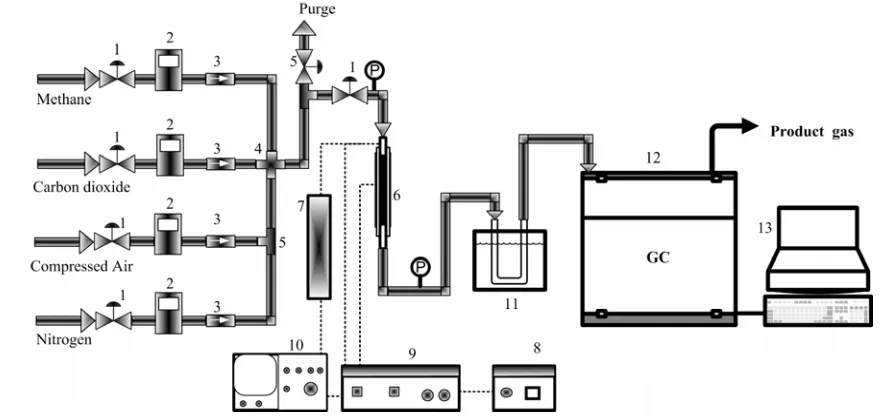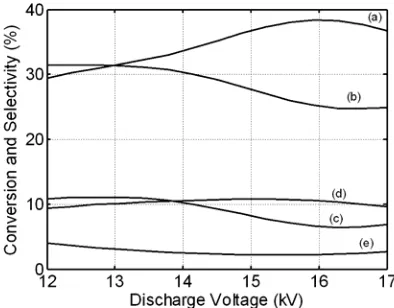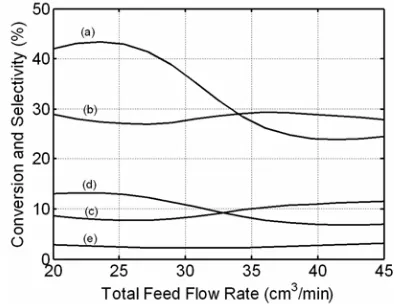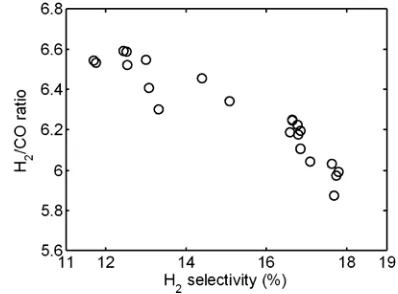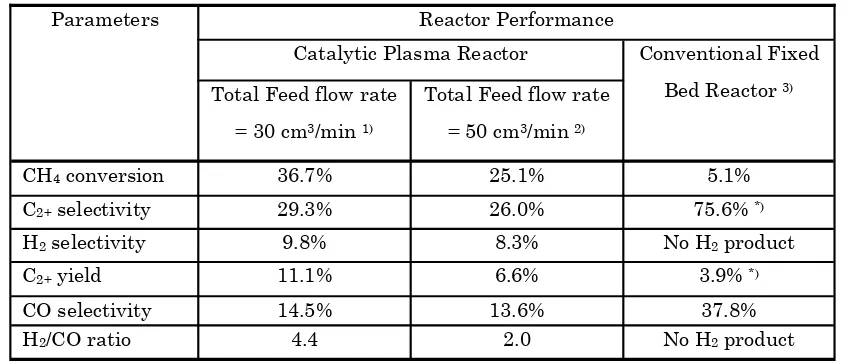Introduction
High energetic electrons in the plasma reactor are potential for development of efficient chemical reactors with low energy requirement. Non-conventional dielectric barrier discharge (DBD) plasma reactor is an efficient tool for converting CH4 and CO2, greenhouse gas contributors, to syn-thesis gas and higher hydrocarbons at low tem-perature and ambient pressure (Caldwell et al., 2001; Larkin et al., 2001; Liu et al., 1999; Zou et al., 2003; Istadi & Amin, 2006a). The energetic electrons collide with molecules in the gas, result-ing in excitation, ionization, electrons
multiplica-Catalytic-Dielectric Barrier Discharge Plasma Reactor For
Methane And Carbon Dioxide Conversion
Istadi
1)*, N.A.S. Amin
2)1) Department of Chemical Engineering, Diponegoro University, Jl. Prof. Sudharto, Kampus
UNDIP Tembalang, Semarang, Indonesia. Telp/Fax: +62-24-7460058
2) Faculty of Chemical & Natural Resources Engineering, Universiti Teknologi Malaysia
* Corresponding Author. Telp/Fax. +62-24-7460058 E-mail address: i.istadi[at]undip.ac.id (Istadi)
Bulletin of Chemical Reaction Engineering & Catalysis, 2(2-3), 2007, 37-44
Presented at Symposium and Congress of MKICS 2007, 18-19 April 2007, Semarang, Indonesia
Abstract
A catalytic - DBD plasma reactor was designed and developed for co-generation of synthesis gas and C2+ hydrocarbons from methane. A hybrid Artificial Neural Network - Genetic Algorithm (ANN-GA) was devel-oped to model, simulate and optimize the reactor. Effects of CH4/CO2 feed ratio, total feed flow rate, dis-charge voltage and reactor wall temperature on the performance of catalytic DBD plasma reactor was ex-plored. The Pareto optimal solutions and corresponding optimal operating parameters ranges based on multi-objectives can be suggested for catalytic DBD plasma reactor owing to two cases, i.e. simultaneous maximization of CH4 conversion and C2+ selectivity, and H2 selectivity and H2/CO ratio. It can be concluded that the hybrid catalytic DBD plasma reactor is potential for co-generation of synthesis gas and higher hy-drocarbons from methane and carbon dioxide and showed better than the conventional fixed bed reactor with respect to CH4 conversion, C2+ yield and H2 selectivity for CO2 OCM process. © 2007 CREC UNDIP. All rights reserved.
.
Keywords: Plasma chemical reactors; Optimization; hybrid ANN-GA; Dielectric-barrier discharge; Pareto Optimal Solution
tion, and formation of atoms and metastable com-pounds (Caldwell et al., 2001; Larkin et al., 2001; Kogelschatz, 2003). When the electric field in the discharge gap is high enough to cause breakdown in most gases, a large number of microdischarges are observed. The active atoms and metastable compounds subsequently collide with molecules and reactions may occur.
Up to recently, only few researchers focused on modeling studies of DBD plasma reactor, but not modeled comprehensively (Eliasson and Kogel-schatz, 1991; Kang et al., 2003) However,
tures on comprehensive plasma modeling in DBD reactor in relation with optimization of process parameters are limited. The comprehensive plasma reactor model should take into account the various fields, such as chemistry, chemical reaction and kinetics, catalysis, and physics which consequently become very complex. The comprehensive plasma reactor model needs a ro-bust numerical solver and time consuming to solve, which is not suitable for rapid prediction in optimization and process control. Due to its abil-ity to model the complex and nonlinear problems, the Artificial Neural Network (ANN) was chosen to model the complex behavior between input and output in the catalytic-DBD plasma process. ANN has been widely used in chemical engineering ap-plications for complex process modeling, process control, and fault detection and diagnosis (Stephanopoulos and Han, 1996; Huang et al., 2003; Radhakrishnan and Suppiah, 2004; Fissore et al., 2004). The combination of ANN and Ge-netic Algorithm (GA) has been used for integrated process modeling and optimization (Nandi et al., 2002, 2004; Ahmad et al., 2004). The hybrid ANN-GA technique is a powerful method for mod-eling and optimization of complex processes which is better than other technique such as response surface methodology.
The present contribution is intended to in-troduce potential of Dielectric Barrier Discharge (DBD) Plasma Reactor for methane and carbon dioxide conversion to synthesis gas and higher hydrocarbons. The multi-objective optimization
(combined ANN-GA) is developed to obtain the range of optimal operating variables.
Experimental and Numerical Methods
Apparatus of DBD Plasma Reactor
The experimental apparatus of DBD plasma reactor is schematically depicted in Fig-ure 1, while the configuration or design of the DBD plasma reactor was presented elsewhere (Istadi & Amin, 2006b). A high voltage AC gen-erator supplied a voltage from 0 kV to 17.5 kV with a pulsed waveform at a frequency of up to 10 kHz was used. The voltage measurement was conducted using an oscilloscope (ISO-TECH ISR 622) equipped with a high voltage probe (manufactured by Atama Tech Sdn. Bhd.) (Istadi, 2006). The Atama’s high voltage probe was cali-brated using Tektronix P6015 High Voltage Probe.
The variables involve are discharge gap width, discharge voltage and frequency, reactant (CH4/CO2) ratio, and total feed flow rate. The DBD plasma reactor was operated without heat-ing and catalyst. The reactor temperature may increase to about 60 oC due to electron heating on the surface of electrode. During the process, the gas temperature can be within the range of room temperature, while the electrons can reach tem-peratures of 104 – 105 K in a dielectric-barrier dis-charge. The non-thermal plasma can be generated by applying a high voltage to a gas space and in-curring gas breakdowns. The gas breakdowns Bulletin of Chemical Reaction Engineering & Catalysis, 2(2-3), 2007, 38
generate electrons that are accelerated by electric field. The electrical discharges can be realized in several ways depending on the types of voltage ap-plied and reactor specification. In the plasma reac-tor, the energetic electrons collide with molecules in the gas, resulting in excitation, ionization, elec-tron multiplication, and the formation of atoms and metastable compounds.
Hybrid Artificial Neural Network – Genetic Algorithm (ANN-GA) Approach for Modeling and Optimization
In this research, the MATLAB environment was used for developing computer codes of genetic algorithm optimization (The Mathworks, 2005). The important think is on how to combine the ANN and the GA algorithms in a hybrid algorithm to support simultaneous modeling and multi-objective optimization (Zhao et al., 2000). The principal fea-tures of the GA are as follows: (a) it requires only scalar values and not the second- and/or first-order derivatives of the objective functions, (b) it is capa-ble of handling nonlinear and noisy objective func-tions, (c) it performs global searches and thus is more likely to arrive at or near the global opti-mum, (d) it does not impose preconditions, such as smoothness, differentiability, and continuity, on the form of the objective function. The detail step-wise procedure for the hybrid ANN-GA algorithm for modeling and optimization was presented else-where (Istadi & Amin, 2006b, 2007).
Design of Experiment
The ANN-based model requires more exam-ple data which are noise-free and statistically well-distributed. However, the ANN-based model is not good at extrapolation. This weakness can be solved by collecting more example data in the regions where extrapolation is required. The design of the experiment was performed using central composite design (CCD) with full factorial design for design-ing traindesign-ing and test data sets. The CCD method is chosen, since the method provides a wider covering region of parameter space and good consideration of variable interactions in the model (Istadi and
Amin, 2006b). The CCD considers low, centre, and high levels of each independent variable. Another advantage of central composite design is to reduce the number of experimental works, but the experi-mental design includes a wider region of parameter space. The variable range and levels of the CCD are presented in Table 1 with respect to the cata-lytic DBD plasma reactor, while the experimental design matrix and the experimental results for validating or training the ANN model are de-scribed elsewhere (Istadi & Amin, 2007).
Results and Discussion
Effect of Operating Parameters in Catalytic DBD Plasma Reactor
This section presents the ANN simulation on the effect of operating parameters in catalytic DBD plasma reactor for CH4 and CO2 conversions. The simulations were carried out by varying one oper-ating parameter, while the remaining parameters were kept constant. CH4 conversion, C2+ hydrocar-bons selectivity and yield, H2 selectivity, and H2/ CO ratio are affected by CH4/CO2 feed ratio, dis-charge voltage, total feed flow rate and reactor wall temperature as depicted in Figures 2-5 from the ANN-based model simulation.
Figure 2 presents the simulation of CH4/CO2 feed ratio effect on the catalytic DBD plasma proc-ess performance. Increasing CH4 concentration in the feed favors the selectivity of C2+ hydrocarbons and hydrogen significantly, but the C2+ hydrocar-bons yield is only slightly affected by decreasing CH4 conversion. It is suggested that CH4 concen-tration in the feed is an essential factor for the to-tal amount of hydrocarbons produced. However, increasing CH4/CO2 ratio to 4 reduces the methane conversion considerably and leads to enhanced C2+ hydrocarbons selectivity and H2/CO ratio. It is con-firmed that CO2 as co-feed has an important role in improving CH4 conversion by contributing some oxygen active species from the CO2. Increasing CO2 concentration in the feed improves the CH4 conver-sion and CO selectivity which may be due to pro-moting the CH4 conversion by oxygen from CO2
Factors Range and levels
- -1 0 +1 +
CH4/CO2 Ratio (X1), [-] 0.8 1.5 2.5 3.5 4.2
Discharge voltage (X2), kV 12.5 13.5 15.0 16.5 17.5
Total feed flow rate (X3), cm3/min 18 25 35 45 52
Reactor temperature (X4), K 355 423 523 623 691
Table 1. Central Composite Design with fractional factorial design for the catalytic DBD plasma reactor
decomposition. This phenomenon is corroborated with the results of Zhang et al. (2001). The yield of gaseous hydrocarbons (C2+) increases slightly with the CH4/CO2 feed ratio as exhibited in Fig-ure 2 and consequently lowers at higher ratio. It is possible to control the composition of C2+ hydro-carbons and hydrogen products by adjusting the CH4/CO2 feed ratio. From the ANN simulation result in Figure 2, it can be shown that increasing CH4/CO2 ratio above 2.5 exhibits low enhance-ment of C2+ yield and lower CH4 conversion. In this work, the composition of the feed gas (CH4/ CO2 ratio) is an important factor to adjust the product distribution. Obviously, more methane in the feed will produce more light hydrocarbons.
The catalyst located in the discharge gap can increase the time and area of contact in addition to other modification of electronic properties. Through the hybrid system, the chemisorption and desorption performances of the catalyst may be modified in the catalyst surface which is de-pendent on the amount and concentration of face charge and the species on the catalyst sur-face (Kim et al., 2004). The results enhancement was also reported by Eliasson et al. (2000) over DBD plasma reactor with high input power of 500 W (20 kV and 30 kHz) where the zeolite catalyst introduction significantly increased the selectivity of light hydrocarbons compared to that in the ab-sence of the zeolite, i.e. C2H6 selectivity from 8.5 to 11.1% and decreased selectivities of C5+ and other oxygenates from 41.2 to 34.2%. The CO se-lectivity slightly decreased when using the zeo-lite, but the formations of carbon and plasma po-lymerization were inhibited.
Varying the discharge power/voltage affects predominantly on methane conversion and higher hydrocarbons (C2-C3) selectivity. The methane conversion increases with discharge voltage as exhibited in Figure 3. More plasma species may be generated at higher discharge voltage. Previ-ous researchers suggested that the conversions of CH4 and CO2 were enhanced mainly with dis-charge power in a catalytic DBD plasma reactor (Caldwell et al., 2001; Eliasson et al., 2000; Zhang et al., 2001, 2002). From Figure 2, the selectivi-ties of C2+ hydrocarbons and hydrogen decrease slightly with the discharge voltage corroborated with the results of Liu et al. (2001). This means that increasing discharge power may destroy the light hydrocarbons (C2-C3). In comparison, high C2 and C3 hydrocarbons selectivities (36.4% and 18%, respectively) were reported by Eliasson et al. (2000) at discharge power of 200 W (30 kHz) using DBD plasma reactor with zeolite catalyst. In this research, the lower range of discharge power (discharge voltage of 12 - 17 kV and
fre-quency being 2 kHz) does not improve the H2 selec-tivity over DBD plasma reactor although the cata-lyst and the heating were introduced in the dis-charge space. Higher disdis-charge voltage is sug-gested to be efficient for methane conversion. As the discharge voltage increases, the bulk gas tem-perature in the reaction zone may also increases. Bulletin of Chemical Reaction Engineering & Catalysis, 2(2-3), 2007, 40
Figure 2. Effect of CH4/CO2 feed ratio on catalytic DBD plasma reactor performance at discharge voltage 15 kV, 30 cm3/min total feed flow rate and reactor temperature 473 K: (a) CH4 conversion, (b) C2+ selectivity, (c) H2 selectivity, (d) C2+ yield, (e) H2/CO ratio
The total feed flow rate also influences pre-dominantly the residence time of gases within the discharge zone in the catalytic DBD plasma reactor which consequently affects collisions between the gas molecules and the energetic electrons. Increas-ing the total feed flow rate reduces the residence time of gases and therefore decreases the methane conversion quickly as demonstrated in Figure 4. A lower feed flow rate is beneficial for producing high yields light hydrocarbons (C2+) and synthesis gases with higher H2/CO ratio as reported by Li et al. (2004). From Figure 4, it is shown that increasing the total feed flow rate decreases the CH4 conver-sion markedly and affects the C2+ hydrocarbons selectivity slightly. The hydrogen selectivity is also affected slightly by the total feed flow rate within the range of operating conditions. Indeed, the total
feed flow rate affects significantly on the methane conversion rather than selectivity of C2+ hydrocar-bons and hydrogen. Actually, the low total feed flow rate (high residence time) leads to high inti-mate collision among the gas molecules, the cata-lyst and high energetic electrons. The high inten-sive collisions favor the methane and carbon diox-ide conversions to C2+ hydrocarbons.
Pertaining to the reactor wall temperature, Figure 5 presents the effect of reactor temperature variation on the performance of catalytic DBD plasma reactor. Thermodynamic equilibrium calcu-lations demonstrated that normal chemical reac-tions between CH4 and CO2 cannot be expected at temperatures lower than 523 K (Istadi and Amin, 2005). In endothermic reactions, normally high temperatures are required to add enthalpy. In this research, the methane and carbon dioxide reaction over CaO-MnO/CeO2 catalyst in the DBD plasma reactor is influenced significantly by energetic elec-trons. The carbon was also formed at the entire surface of electrode during the reaction. A good plasma catalytic activity was achieved only when streamer discharges were present. At higher tem-peratures, the streamer discharge may turn to an arc-like discharge and thermal effects dominate the reactions. The non-equilibrium streamer dis-charge at lower temperatures favored the forma-tion of the higher hydrocarbons. From Figure 5, it is evident that the current range of reactor tem-perature (373-673 K) only affects the catalytic DBD plasma reactor slightly. The methane conversion is slightly affected by reactor wall temperature over the CaO-MnO/CeO2 catalyst. The C2+ hydrocar-bons selectivity is enhanced slightly by the reactor temperature which may be due to the altering the catalyst surface phenomena. The adsorption-desorption, heterogeneous catalytic and electronic properties of the catalysts may change the surface reaction activity when electrically charged. How-ever, the chemistry and physical phenomena at the catalyst surface can not be determined in the sense of traditional catalyst.
Pareto-Optimal Solutions of Multi-objectives Optimization using Hybrid ANN-GA Strategy
Five objectives should be maximized simultane-ously corresponding to four operating parameters. The simultaneous maximization is intended to come close to the real conditions of the process, but huge number of objectives to be optimized simulta-neously, the more difficult the optimization process is. To simplify the optimization problem, the opti-mization of noncatalytic DBD plasma reactor is divided into two separate cases, i.e: (a) simultane-ous maximization of CH4 conversion and C2+ selec-tivity (Case 1), and (b) simultaneous maximization Figure 4. Effect of total feed flow rate on
cata-lytic DBD plasma reactor performance at CH4/CO2 feed ratio 2.5, discharge voltage 15 kV and reactor temperature 473 K: (a) CH4 conver-sion, (b) C2+ selectivity, (c) H2 selectivity, (d) C2+ yield, (e) H2/CO ratio
Figure 5. Effect of reactor wall temperature on catalytic DBD plasma reactor performance at CH4/CO2 feed ratio 2.5, discharge voltage 15 kV and total feed flow rate 30 cm3/min: (a) CH4 con-version, (b) C2+ selectivity, (c) H2 selectivity, (d) C2+ yield, (e) H2/CO ratio
of H2 selectivity and H2/CO ratio (Case 2). The choice of two objective functions for each case en-ables the simultaneous maximization of the real process performances and simplifies the optimiza-tion problems.
The Pareto optimal solutions of catalytic DBD plasma reactor for CH4 and CO2 conversions process are depicted in Figure 6 with respect to simultaneous maximization of CH4 conversion and C2+ hydrocarbons selectivity. The Pareto op-timal solutions points are obtained by varying the weighting factor (wk) and performing the GA opti-mization corresponding to each wk (0 ≤ wk ≤ 1). From the figure, it is found that if the CH4 con-version increases, the C2+ selectivity decreases, where all sets of non-inferior/Pareto optimal solu-tions are acceptable. CH4 conversion can achieve as high as 23.5% with C2+ selectivity equal to 39.6%, while the C2+ selectivity can be obtained as high as 29.9% with CH4 conversion equal to 47.0%. The results can be achieved by altering the
operating parameters of CH4/CO2 feed ratio, dis-charge voltage, total feed flow rate and reactor wall temperature from 4.0, 12.8 kV, 25.2 cm3/min and 423 K to 2.2, 12.8 kV, 20 cm3/min and 423 K, respectively. CH4 conversion improves at lower CH4/CO2 ratio, since high CO2 concentration in the feed improves the decomposition of methane. The C2+ selectivity increases with CH4/CO2 ratio. Increasing the total feed flow rate decreases the CH4 conversion and enhances the C2+ selectivity slightly which is in agreement with the results of Eliasson et al. (2000) and Liu et al. (1998). How-ever, CH4 conversion and C2+ selectivity are only slightly affected by the discharge voltage and the reactor temperature within the range of Pareto optimal solutions.
Pertaining to simultaneous maximization of H2 selectivity and H2/CO ratio (Case 2), the Pareto optimal solution is presented in Figures 7. From the figure, it was found that the Pareto op-timal solution shows non inferior feature where H2 selectivity increases at decreasing H2/CO ratio within the Pareto zone. H2 selectivity can achieve as high as 17.8% with H2/CO ratio equal to 5.9, while the H2 selectivity can be obtained as high as 11.7% with H2/CO ratio equal to 6.6%. The opti-mal operating parameters suitable for simultane-ous optimization of H2 selectivity and H2/CO ratio can be recommended where CH4/CO2 ratio being 3.9-4.0, discharge voltage about 14.0 kV, total feed flow rate being about 20-40 cm3/min, and reactor temperature being 373-453 K. Higher CH4 concentration enhances the H2 selectivity, but not for discharge voltage. The discharge voltage does not influence the H2 selectivity. It is shown that the H2 selectivity is influenced slightly by reactor wall temperature in the catalytic DBD plasma reactor.
Comparison between DBD Plasma and Con-ventional Fixed Bed Reactors at the Same Feed Flow Rate and Catalyst
Table 2 presents the comparison between catalytic DBD plasma reactor and conventional fixed bed reactor at the same total feed flow rate and catalyst (Istadi, 2006). From the table, it is shown that the catalytic DBD plasma reactor is better than the conventional fixed bed reactor with respect to CH4 conversion, C2+ yield and H2 selectivity. In addition, the C2+ hydrocarbons re-sulted from catalytic DBD plasma reactor include ethane (C2H6), ethylene (C2H4), acetylene (C2H2), and propane (C3H8), while those of conventional fixed bed reactor include only ethane and ethyl-ene. The DBD plasma reactor produces some hy-drogen, while the conventional fixed bed reactor does not produce hydrogen. However, the C2+ se-Bulletin of Chemical Reaction Engineering & Catalysis, 2(2-3), 2007, 42
Figure 6. Pareto optimal solutions obtained from simultaneous maximization of CH4 conversion and C2+ selectivity for catalytic DBD plasma reactor
lectivity of DBD plasma reactor is still lower than that of conventional reactor. Pertaining to DBD plasma reactor, lower total feed flow rate (30 cm3/ min) shows better performance than higher feed flow rate (50 cm3/min). Another benefit of catalytic DBD plasma reactor is that only very low tempera-ture of the reactor is required to do the process, because in fact the high energetic electrons are produced in the discharge zone (achieve 104-105 K). Indeed, the hybrid catalytic DBD plasma reactor is effective for co-generation of C2+ hydrocarbons and synthesis gas from methane and carbon dioxide.
Conclusions
The hybrid catalytic DBD plasma reactor is potential for co-generation of C2+ hydrocarbons and synthesis gases from methane and carbon dioxide. A hybrid artificial neural network – genetic algo-rithm was developed to model, to simulate and to optimize the catalytic DBD plasma reactor. A study on the effects of CH4/CO2 feed ratio, total feed flow rate, discharge voltage and reactor tem-perature on the performance of hybrid catalytic DBD plasma reactor at low temperature was ad-dressed by the ANN-based model simulation with good fitting. It can be concluded that three factors, i.e. CH4/CO2 feed ratio, total feed flow rate, and discharge voltage, showed significant effects on the reactor performances. However, increasing the re-actor wall temperature has no apparent influence
on the selectivity to C2+ hydrocarbons and hydro-gen within the investigated range. The Pareto opti-mal solutions and corresponding optiopti-mal operating parameters ranges produced by multi-objectives optimization can be suggested owing to simultane-ous maximization of CH4 conversion and C2+ selec-tivity, and/or H2 selectivity and H2/CO ratio. It can be concluded that the hybrid catalytic DBD plasma reactor is more suitable for CO2 OCM process than the conventional catalytic reactor over CaO-MnO/ CeO2 catalyst. The synergism of the catalyst and the plasma affects the products distribution, par-ticularly C2+ hydrocarbons selectivity.
References
[1] Ahmad, A.L., Azid, I.A., Yusof, A.R., Seetharamu, K.N., (2004). “Emission Control in Palm Oil Mills using Artificial Neural Network and Genetic Algo-rithm”. Comp. Chem. Eng., 28, 2709-2715.
[2] Caldwell, T.A. et al. (2001). “Partial Oxidation of Methane to Form Synthesis Gas in a Tubular AC Plasma Reactor”, in: Spivey, J.J., Iglesia, E., Fleisch, T.H. (Eds.), Stud. Surf. Sci. Cat., Elsevier B.V., Amsterdam, 136, pp. 265-270.
[3] Eliasson, B., Kogelschatz, U. (1991). Modeling and Applications of Silent Discharges Plasmas. IEEE Trans.. Plasma Sci., 19, 309-323.
[4] Eliasson, B., Liu, C.J., Kogelschatz, U. (2000). Di-rect Conversion of Methane and Carbon Dioxide to
Table 2. Comparison between plasma and conventional fixed bed reactors at the same catalyst (12.8CaO-6.4MnO/CeO2) and total feed flow rate
Parameters Reactor Performance
Catalytic Plasma Reactor Conventional Fixed Bed Reactor 3) Total Feed flow rate
= 30 cm3/min 1)
Total Feed flow rate = 50 cm3/min 2)
CH4 conversion 36.7% 25.1% 5.1%
C2+ selectivity 29.3% 26.0% 75.6% *)
H2 selectivity 9.8% 8.3% No H2 product
C2+ yield 11.1% 6.6% 3.9% *)
CO selectivity 14.5% 13.6% 37.8%
H2/CO ratio 4.4 2.0 No H2 product
*) comprises only C
2H6 and C2H4
1) From ANN model simulation: Discharge voltage = 16 kV, Frequency = 2 kHz, T= 473 K, CH
4/CO2 ratio = 3,
To-tal feed flow rate = 30 cm3/min
2) From ANN model simulation: Discharge voltage = 16 kV, Frequency = 2 kHz, T= 473 K, CH4/CO2 ratio = 3,
To-tal feed flow rate = 50 cm3/min
3) CO2/CH4 = 2, T = 1127 K, total feed flow rate = 50 cm3/min
Higher Hydrocarbons using Catalytic Dielectric-Barrier Discharges with Zeolites. Ind. Eng. Chem. Res., 39, 1221-1227.
[5] Eliasson, B., Liu, C.J., Kogelschatz, U. (2000). Di-rect Conversion of Methane and Carbon Dioxide to Higher Hydrocarbons using Catalytic Dielectric-Barrier Discharges with Zeolites. Ind. Eng. Chem. Res., 39, 1221-1227.
[6] Fissore, D., Barresi, A.A., Manca, D. (2004). Mod-elling of Methanol Synthesis in A Network of Forced Unsteady-state Ring Reactor by Artificial Neural Networks for Control Purposes. Chem. Eng. Sci., 59, 4033-4041.
[7] Huang, K., Zhan, X.L., Chen, F.Q., Lü, D.W. (2003). Catalyst Design for Methane Oxidative Coupling by Using Artificial Neural Network and Hybrid Genetic Algorithm. Chem. Eng. Sci., 58, 81-87.
[8] Istadi and Amin, N.A.S. (2006b),"A Hybrid Arti-ficial Neural Network - Genetic Algorithm (ANN-GA) Technique for Modelling and Optimi-zation of Plasma Reactor", Ind. Eng. Chem. Res, 45: 6655-6664.
[9] Istadi and Amin, N.A.S., (2007), "Modelling and Optimization of Catalytic-Dielectric Barrier Dis-charge Plasma Reactor for Methane and Carbon Dioxide Conversion Using Hybrid Artificial Neu-ral Network – Genetic Algorithm Technique",
Chem. Eng. Sci., Elsevier B.V. (Article In Press) [10] Istadi, and Amin, N.A.S. (2005). A
Thermody-namic Analysis of Co-generation of C2
Hydrocar-bons and Synthesis Gases from Methane and Carbon Dioxide by Direct Gibbs Free Energy Minimization. J. Nat. Gas Chem., 14, 140-150. [11] Istadi, and Amin, N.A.S. (2006a). Co-Generation
of Synthesis Gas and C2+ Hydrocarbons from
Methane – Carbon Dioxide Reaction in A Hybrid Catalytic Plasma Reactor: A Review. Fuel, 85, 577-592.
[12] Istadi. (2006). Catalytic Conversion of Methane and Carbon Dioxide in A Conventional Fixed Bed and Dielectric-Barrier Discharge Plasma Reactors. PhD Thesis, Universiti Teknologi Ma-laysia.
[13] Kang, W.S., Park, J.M., Kim, Y., Hong, S.H. (2003). Numerical Study on Influences of Barrier Arrangements on Dielectric Barrier Discharge Characteristics. IEEE Trans. Plasma Sci., 31, 504-510.
[14] Kim, S.S., Lee, H., Na, B.K., and Song, H.K. (2004). Plasma-assisted Reduction of Supported Metal Catalyst using Atmospheric Dielectric-barrier Discharge. Catal. Today, 89, 193-200. [15] Kogelschatz, U. (2003). Dielectric-barrier
Dis-charges: Their History, Discharge Physics, and Industrial Applications. Plasma Chem. Plasma Proc., 23, 1-46.
[16] Larkin, D.W., Zhou, L., Lobban, L.L., Mallinson, R.G. (2001). Product Selectivity Control and Or-ganic Oxygenate Pathways from Partial
Oxida-tion of Methane in a Silent Electric Discharge Reactor. Ind. Eng. Chem. Res., 40, 5496-5506. [17] Li, M.W., Xu, G.H., Tian, Y.L., Chen, L., and Fu,
H.F. (2004). Carbon Dioxide Reforming of Meth-ane Using DC Corona Discharge Plasma Reac-tion. J. Phys. Chem.: A, 108, 1687-1693.
[18] Liu, C.J., Mallinson, R., Lobban, L. (1998). Non-oxidative Methane Conversion to Acetylene over Zeolite in A Low Temperature Plasma. J. Catal., 179, 326-334.
[19] Liu, C.J., Xu, G.H., Wang, T. (1999). Non-Thermal Plasma Approaches in CO2 Utilization.
Fuel Proc. Technol., 58, 119-134.
[20] Liu, C.J., Xue, B., Eliasson, B., He, F., Li, Y. and Xu, G.H. (2001). Methane Conversion to Higher Hydrocarbons in the Presence of Carbon Dioxide using Dielectric Barrier-Discharge Plasmas.
Plasma Chem. Plasma Proc., 21, 301-309. [21] Nandi, S., Badhe, Y., Lonari, J., Sridevi, U., Rao,
B.S., Tambe, S.S., Kulkarni, B.D. (2004). Hybrid Process Modeling and Optimization Strategies Integrating Neural Networks/Support Vector Regression and Genetic Algorithms: Study of Benzene Isopropylation on Hbeta Catalyst.
Chem. Eng. J., 97, 115-129.
[22] Nandi, S., Mukherjee, P.,Tambe, S.S., Kumar, R., Kulkarni, B.D. (2002). Reaction Modeling and Optimization Using Neural Networks and Genetic Algorithms: Case Study Involving TS-1 Catalyzed Hydroxylation of Benzene. Ind. Eng. Chem. Res., 41, 2159-2169.
[23] Radhakrishnan, V.R., Suppiah, S. (2004). Ham-merstein Type Model of An Industrial Heat Ex-changer. Proc. the 18th Symposium of Malaysian Chemical Engineers. Universiti Teknologi Petro-nas, Perak, Malaysia.
[24] Stephanopoulos, G., Han, C. (1996). Intelligent System in Process Engineering: A Review.
Comp. Chem. Eng., 20, 743-791.
[25] The Mathworks. (2005). Genetic Algorithm and Direct Search Toolbox for Use with MATLAB, The Mathworks, Inc., Natick, MA.
[26] Zhang, K., Eliasson, B., and Kogelschatz, U. (2002). Direct Conversion of Greenhouse Gases to Synthesis Gas and C4 Hydrocarbons over Zeo-lite HY Promoted by a Dielectric-Barrier Dis-charge. Ind. Eng. Chem. Res, 41, 1462-1468. [27] Zhang, K., Kogelschatz, U. and Eliasson, B.
(2001). Conversion of Greenhouse Gases to Syn-thesis Gas and Higher Hydrocarbons. Energy Fuels, 15, 395-402.
[28] Zhao, W., Chen, D., Hu, S. (2000). Optimizing Operating Conditions Based on ANN and Modi-fied GAs. Comp. Chem. Eng., 24, 61-65.
[29] Zou, J.J., Zhang, Y., Liu, C.J., Li, Y., Eliasson, B. (2003). Starch-enhanced Synthesis of Oxygen-ates from Methane and Carbon Dioxide Using Dielectric-barrier Discharges. Plasma Chem. Plasma Proc., 23, 69-82.
Bulletin of Chemical Reaction Engineering & Catalysis, 2(2-3), 2007, 44
